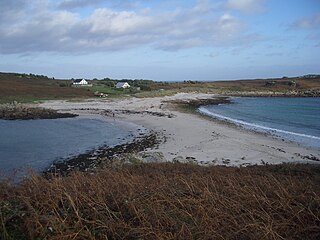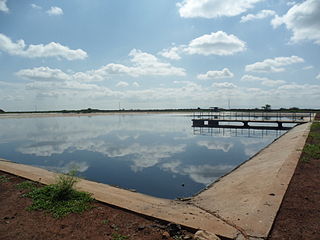| Look up lagoon in Wiktionary, the free dictionary. |
A lagoon is a shallow body of water separated from a larger body of water by reefs, barrier islands, or a barrier peninsula.
Contents
Lagoon may also refer to:
| Look up lagoon in Wiktionary, the free dictionary. |
A lagoon is a shallow body of water separated from a larger body of water by reefs, barrier islands, or a barrier peninsula.
Lagoon may also refer to:

Padre Island National Seashore (PINS) is a national seashore located on Padre Island off the coast of South Texas. In contrast to South Padre Island, known for its beaches and vacationing college students, PINS is located on North Padre Island and consists of a long beach where nature is preserved.

An estuary is a partially enclosed coastal body of brackish water with one or more rivers or streams flowing into it, and with a free connection to the open sea. Estuaries form a transition zone between river environments and maritime environments and are an example of an ecotone. Estuaries are subject both to marine influences such as tides, waves, and the influx of saline water and to fluvial influences such as flows of freshwater and sediment. The mixing of seawater and freshwater provides high levels of nutrients both in the water column and in sediment, making estuaries among the most productive natural habitats in the world.

A lagoon is a shallow body of water separated from a larger body of water by a narrow landform, such as reefs, barrier islands, barrier peninsulas, or isthmuses. Lagoons are commonly divided into coastal lagoons and atoll lagoons. They have also been identified as occurring on mixed-sand and gravel coastlines. There is an overlap between bodies of water classified as coastal lagoons and bodies of water classified as estuaries. Lagoons are common coastal features around many parts of the world.
Chuuk or Truk may refer to:

In oceanography, geomorphology, and geoscience, a shoal is a natural submerged ridge, bank, or bar that consists of, or is covered by, sand or other unconsolidated material and rises from the bed of a body of water to near the surface. It often refers to those submerged ridges, banks, or bars that rise near enough to the surface of a body of water as to constitute a danger to navigation. Shoals are also known as sandbanks, sandbars, or gravelbars. Two or more shoals that are either separated by shared troughs or interconnected by past or present sedimentary and hydrographic processes are referred to as a shoal complex.
DBD may refer to:

Waste stabilization ponds are ponds designed and built for wastewater treatment to reduce the organic content and remove pathogens from wastewater. They are man-made depressions confined by earthen structures. Wastewater or "influent" enters on one side of the waste stabilization pond and exits on the other side as "effluent", after spending several days in the pond, during which treatment processes take place.

Agricultural wastewater treatment is a farm management agenda for controlling pollution from confined animal operations and from surface runoff that may be contaminated by chemicals in fertilizer, pesticides, animal slurry, crop residues or irrigation water. Agricultural wastewater treatment is required for continuous confined animal operations like milk and egg production. It may be performed in plants using mechanized treatment units similar to those used for industrial wastewater. Where land is available for ponds, settling basins and facultative lagoons may have lower operational costs for seasonal use conditions from breeding or harvest cycles. Animal slurries are usually treated by containment in anaerobic lagoons before disposal by spray or trickle application to grassland. Constructed wetlands are sometimes used to facilitate treatment of animal wastes.
An aerated lagoon is a simple wastewater treatment system consisting of a pond with artificial aeration to promote the biological oxidation of wastewaters.
Backwater or Backwaters may refer to:
A pond is a small body of standing water.
An anaerobic lagoon or manure lagoon is a man-made outdoor earthen basin filled with animal waste that undergoes anaerobic respiration as part of a system designed to manage and treat refuse created by concentrated animal feeding operations (CAFOs). Anaerobic lagoons are created from a manure slurry, which is washed out from underneath the animal pens and then piped into the lagoon. Sometimes the slurry is placed in an intermediate holding tank under or next to the barns before it is deposited in a lagoon. Once in the lagoon, the manure settles into two layers: a solid or sludge layer and a liquid layer. The manure then undergoes the process of anaerobic respiration, whereby the volatile organic compounds are converted into carbon dioxide and methane. Anaerobic lagoons are usually used to pretreat high strength industrial wastewaters and municipal wastewaters. This allows for preliminary sedimentation of suspended solids as a pretreatment process.
Crybaby, Cry-Baby, CryBaby or Cry Baby may refer to:

A deep geological repository is a way of storing hazardous or radioactive waste within a stable geologic environment. It entails a combination of waste form, waste package, engineered seals and geology that is suited to provide a high level of long-term isolation and containment without future maintenance. This will prevent any radioactive dangers. A number of mercury, cyanide and arsenic waste repositories are operating worldwide including Canada and Germany and a number of radioactive waste storages are under construction with the Onkalo in Finland being the most advanced.

Cedar Point Shores is a water park located adjacent to Cedar Point in Sandusky, Ohio. It is owned and operated by Cedar Fair.
A waste pond or chemical pond is a small impounded water body used for the disposal of water pollutants, and sometimes utilized as a method of recycling or decomposing toxic substances. Such waste ponds may be used for regular disposal of pollutant materials or may be used as upset receivers for special pollution events. Often, chemical ponds themselves are addressed for cleanup action after their useful life is over or when a risk of groundwater contamination arises. Peak usage of waste ponds in the United States occurred in the period 1955 to 1985, after which the environmental risks of pond technology were sufficiently understood, such that alternative technologies for waste disposal gradually began to displace many of the waste ponds. Waste ponds often have pond liners, such as concrete or robust synthetic polymeric materials, to prevent infiltration of chemicals to soil or groundwater.

Facultative lagoons are a type of waste stabilization pond used for biological treatment of industrial and domestic wastewater. Sewage or organic waste from food or fiber processing may be catabolized in a system of constructed ponds where adequate space is available to provide an average waste retention time exceeding a month. A series of ponds prevents mixing of untreated waste with treated wastewater and allows better control of waste residence time for uniform treatment efficiency.
Esquimalt is a municipality in British Columbia.
A treatment pond is intended to provide wastewater treatment to achieve a certain effluent quality. Ponds are depressions holding water confined by earthen structures.